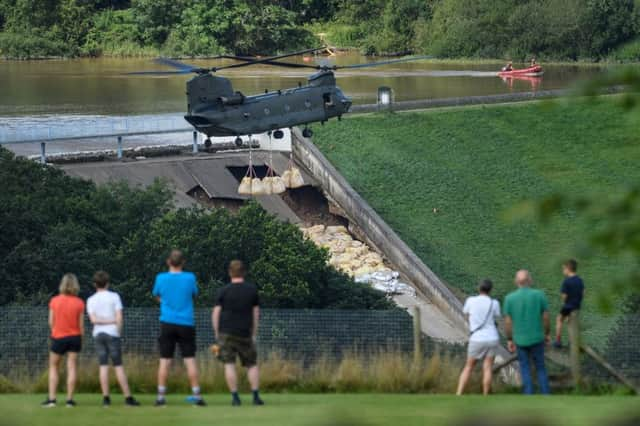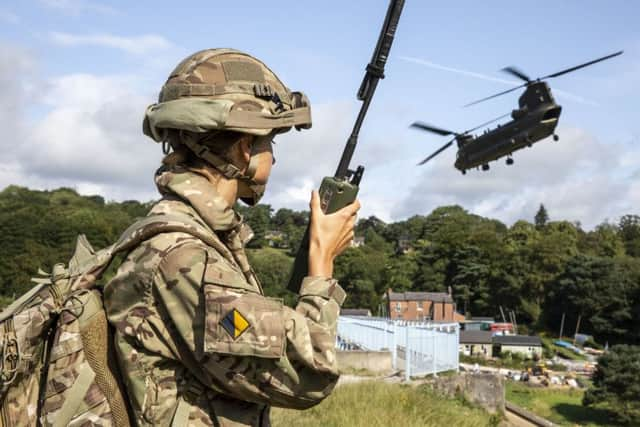What Whaley Bridge and Todmorden reservoir crises tell us about attitudes to the North: Jayne Dowle


That’s probably why we have been following the story of the Whaley Bridge dam obsessively for the past week or so. It’s the unnerving sight and sound of a Chinook helicopter flying over a perfectly ordinary town in the middle of a peacetime summer’s afternoon – or as Edwina Currie, the former Conservative MP who lives nearby, put it: “It was like Good Morning, Vietnam.”
It’s the faces of the stricken residents, who must flee like refugees from a war zone and find themselves homeless; the prospect of all that you have held safe and secure being washed away. What must it be like to lose everything? To have to run for your lives, leaving behind your pets? (This one particularly bothers Lizzie) What about work and businesses? (This one particularly bothers me).
Advertisement
Hide AdAdvertisement
Hide AdAnd with good reason. A local bakery, which supplies farm shops, delis and Harvey Nichols, tells The Grocer trade publication that the evacuation has cost the company £8,000 in lost profits. And I read one interview with a carer who said that the disruption had caused her to lose a fortnight’s wages, with no offer of any kind of compensation. The local Labour MP, Ruth George, said that she had written to the Prime Minister to ask what could be done. That’s the true cost of climate change, whether you believe it exists or not. And no government has as yet begun to calculate it.


For his part, and with the instructions “don’t forget the North (or even the North Midlands)” clearly tattooed across his forehead, Boris Johnson turned up, rather to the surprise of everybody, and visited some Whaley Bridge residents holed up in a chapel. Clearly channelling his inner Churchill, he urged them to carry on in the good old Brexit spirit that had won us two world wars and declared the dam to be “dodgy but stable”, which could apply to a lot of other things surrounding the new man at Number 10.
Such a grim fascination with “what if the worst happened?” is best left to the imagination. However, for the residents of this small town in the Peak District, across the Pennines from South Yorkshire, the threat of the 188-year-old Toddbrook dam collapsing and sending 300 million of gallons of water cascading down the valley, destroying homes, businesses and lives, has been perilously close to reality.
These ‘extreme weather events’ as we must now call storms, put the country in interesting perspective. I always try to avoid slipping into default Northerner mode, but I was struck by how little relative interest national newspapers seemed to take in the Whaley Bridge story.
Advertisement
Hide AdAdvertisement
Hide AdWhat if the threat of dam collapse had been in Reading say, or Surrey? I want to see more questions being asked and more answers being listened to. At a meeting of the Cabinet’s emergency committee, Cobra, the new Environment Secretary, Theresa Villiers, was warned of the dangerous consequences of failing to build new infrastructure to cope with the dramatic changes in climate we are experiencing.
Bob Ward, a policy director at the Grantham Research Institute on Climate Change and the Environment, told her straight: “We have the flood defence system fit for the climate of the 20th century when we need it fit for the 21st century. We are going to see more record rainfall, more flooding along our coasts and rivers, and we are just not prepared for that.”
Thanks to the sterling efforts of fire crews and the Army, the water levels at Whaley Bridge are now stabilising. The immediate threat to life has passed; but by no means has the crisis abated. It is only just beginning.
Indeed, earlier this week, roads were closed and residents warned of potential evacuation around the Lumbutts reservoir in Todmorden in West Yorkshire due to similar flood fears.
Advertisement
Hide AdAdvertisement
Hide AdAfter a seriously scary experience driving over the M62 on Sunday afternoon in the middle of another ‘extreme weather event’, not far from Todmorden, I’m not surprised. This was angry, apocalyptic rain. Massive hailstones hammered down on the car. Thunder and lightning battled each other overhead. The carriageway turned into a fast-flowing river itself. I marvelled – not for the first time on the highest stretch of motorway in England – at how so many motorists manage to get from one end to the other without accident in bad weather.
Thunder, heavy rain and high winds are forecast to descend again later this week. Who knows what will happen next, or where? But one thing is certain: The Rock won’t be coming to save any of us. We must, as a society, start to take steps to save ourselves. And we need our political leaders to wake up to this now, not when we’re up to our necks in it.